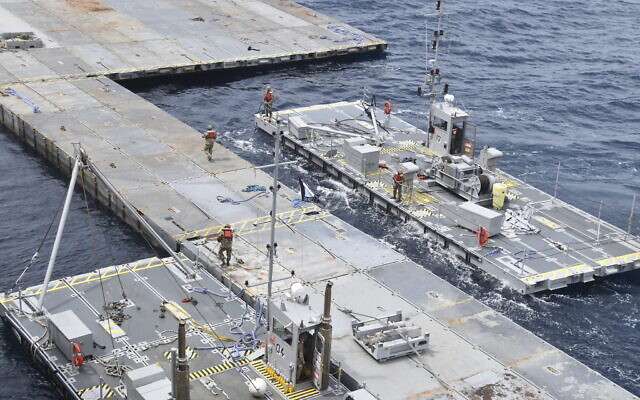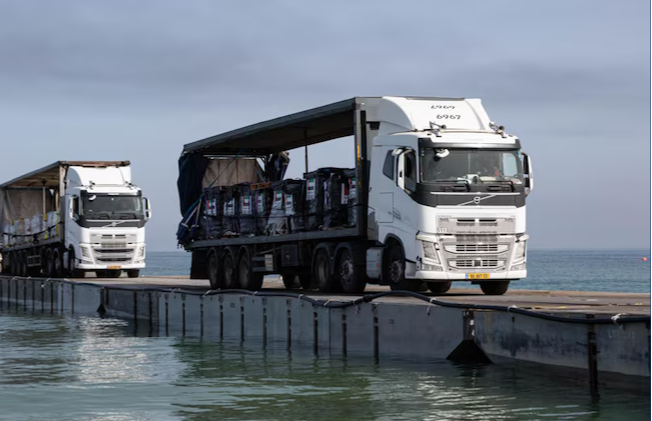
UPDATE:


Original Post:
The U.S. Central Command press release is short, even modest:
Today [May 16] at approximately 7:40 a.m. (Gaza time) United States Central Command personnel supporting the humanitarian mission to deliver additional humanitarian aid to Palestinian civilians in need anchored a temporary pier to the beach in Gaza. As part of this effort, no U.S. troops entered Gaza. Trucks carrying humanitarian assistance are expected to begin moving ashore in the coming days. The United Nations will receive the aid and coordinate its distribution into Gaza.
Modest because it is the culmination of an ambitious, desperately needed, much criticized, even opposed, humanitarian project that met the ambitious schedule set by the Commander in Chief two months ago. A project fraught with logistical, weather and security challenges
A project completed in the nick of time as aid agencies are running out of food, fuel and critical medical supplies and as military operations in Rafah, where more than 1.4 million Palestinians are sheltering, threaten to disastrously worsen the humanitarian crisis in Gaza.
The project, known as JLOTS, or “Joint Logistics Over-the-Shore” capability, consists of a floating dock about three miles off the Gaza shore, a floating pier attached to an approximately 1,800-foot-long modular causeway anchored to the shore and, finally, a group of logistic support vessels (LSVs) that will transport the aid from the dock to the pier/causeway.
Once fully operational, JLOTS will permit the delivery of up to 2,000,000 meals per-day for Gaza’s 2.3 million people, starting with an estimated daily transport of 90 truckloads, eventually ramping up to 150 truckloads when the pier-causeway is fully operational.
There have been numerous narratives of the project and its goals, but Vice Admiral Brad Cooper, deputy commander of US Central Command provided perhaps the best and most up-to-date description during a special on-line briefing yesterday.
For sure, delivering humanitarian aid from the sea is unique and complex. For context on the magnitude of this effort, there are 14 U.S. and partner ships of various sizes solely focused on this one mission of delivering assistance to the people of Gaza.
First, humanitarian assistance comes into Cyprus via air or sea, where it is screened, palletized, and prepared for delivery. Pallets of aid are then loaded into large commercial or military vessels that travel from Cyprus to a large floating platform that we have assembled and is anchored several kilometers off the coast of Gaza. The floating platform acts as a stable workspace to transload pallets from the larger commercial ships onto smaller U.S. military vessels that can reach closer to shore. These smaller ships can carry between five and 15 trucks of aid each.
The smaller ships then shuttle these trucks with aid from the floating platform to a temporary pier – basically, a floating causeway that is several hundred meters long that is fixed to the beach in Gaza. So, aid goes from the floating platform onto trucks, onto the small ships; the floating – then from the small ships onto the floating causeway; the trucks roll down the causeway onto land and commodities are dropped off on land.
…after commodities are ashore, the UN and World Food Program will receive the humanitarian aid for onward distribution inside Gaza. These are two separate processes.
The Admiral goes on to thank the many international donors, partner nations and the international community for their support and contributions.
He is not oblivious to the risks associated with the mission. “[Force protection] is our top priority,” Admiral Cooper says. “We take the security of our service members and the humanitarian aid workers very seriously. As a point of emphasis, this a 100 percent humanitarian mission and any attack on those working on it, on this mission, is an attack on aid for the people of Gaza. We will continue to assess and reassess security to inform our operation every day.”
And indeed, while the IDF will be responsible for on-shore security, the U.S. has two US Navy warships near the area in the eastern Mediterranean Sea, the USS Arleigh Burke and the USS Paul Ignatius to “to protect American troops offshore and allies on the beach.”
The MV Sagamore loaded with 475 pallets of food left Cyprus last week and has already transferred the pallets to the U.S. military ship Roy P. Benavidez off the coast of Gaza, which should be the first vessel to offload essential humanitarian aid to a region that is in “full-blown famine.”
















